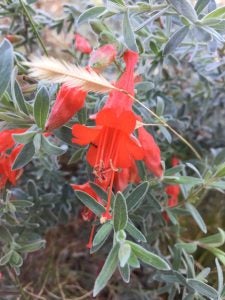 Epilobium canum (Onagraceae) is a flowering shrub endemic to California. As a summer/fall-flowering plant with ample nectar, it is an important food source for pollinators and other insect species that are active in the late summer and early fall. Many ecotypes and horticultural varieties of Epilobium canum are available for purchase (e.g. from Calflora Nursery). These varieties and cultivars range widely in their phenotype and as a result, their attractiveness to and use by pollinators.
Epilobium canum (Onagraceae) is a flowering shrub endemic to California. As a summer/fall-flowering plant with ample nectar, it is an important food source for pollinators and other insect species that are active in the late summer and early fall. Many ecotypes and horticultural varieties of Epilobium canum are available for purchase (e.g. from Calflora Nursery). These varieties and cultivars range widely in their phenotype and as a result, their attractiveness to and use by pollinators.
Research in the Vannette lab on the California fuchsia examines which floral traits are attractive to pollinators, variation among cultivar types, with the goal of linking floral traits, pollinator attraction, and the microbial communities found in nectar. The plants we study are found in the UC Davis Arboretum, and we partner with arboretum staff to design pollinator plantings in the gateway garden and other themed plantings. Much of this research is student-driven, in fact, our Epilobium research is the focus of one introductory class for the Animal Biology major (ABI50A, taught fall quarter). Students participate in data collection for an ongoing long-term study by the Vannette lab, then have a chance to design their own study to investigate links among plant and floral phenotypes, visitation by hummingbirds (Calypte anna), honey bees or carpenter bees (Xylocopa spp), or other species interactions within this system.
See a summary of our past work in this system below:
[scribd id=432417302 key=key-tPcarXfGZvpMHsvXLVm1 mode=scroll]Publications from this system include:
Morris M., Frixione NJ, Dinsdale EA, Vannette RL. Nectar microbiome structure and function changes over time and with dispersal vectors. Under review.
Work in this system has been supported by: